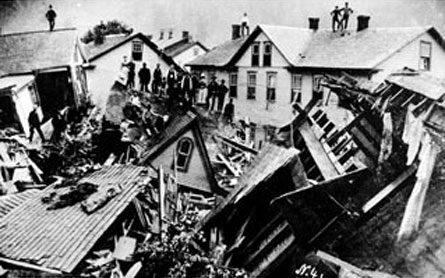PORTLAND, Ore. — The devastating flow released when a dam burst upstream of Johnstown, Pa., in May 1889 transformed a small, normally tranquil river into a raging torrent that briefly rivaled the mighty Mississippi, a new study reveals.

Johnstown, which lies about 100 kilometers east of Pittsburgh, was a thriving coal- and iron-producing town in the years following the Civil War, says Carrie Davis Todd, a hydrologist at the University of Pittsburgh at Johnstown. Then, on the rainy afternoon of May 31, 1889, disaster struck: A dam about 23 kilometers upstream of the town burst, sending a wall of debris-filled water down the narrow valley of the Little Conemaugh River to ravage the town. More than 2,200 people died in the disaster — a death toll aggravated by the fact that even before the dam burst, flood waters filling the streets of Johnstown had trapped many residents in their homes, she reported here October 19 at the annual meeting of the Geological Society of America.
Despite the event’s massive death toll, few detailed studies of the flood have been done, says Dan Ingram, curator at the Johnstown Area Heritage Association. “There’s a ton of anecdotal information, but few people have ever looked at it in a scientific way,” he notes.
Enter Davis Todd and her colleagues, who recently embarked on a project to analyze the Johnstown Flood. Using modern-day surveys of the area around the dam as well as archival photos, the researchers estimate that the 1.6-square-kilometer reservoir behind the dam held about 15 million cubic meters of water. The pressure of those accumulated waters, as well as erosion that occurred as water spilled over the top of the dam, triggered a sudden and catastrophic failure, says Davis Todd. Peak discharge through the 90-meter-wide, 13-meter-high breach in the dam exceeded 8,500 cubic meters per second — about three times the flow rate across Niagara Falls.
As devastating as that torrent would have been, the flow rate that slammed into Johnstown was even higher, the researchers estimate. Large amounts of rocks, trees and other debris swept along by the initial surge of floodwaters were temporarily trapped against a narrow bridge about four kilometers downstream of the dam. The deluge released by the dam’s collapse carried more than 12,000 cubic meters of debris-filled water each second. Flow rates in the Mississippi River typically vary between 7,000 and 20,000 cubic meters per second, says Davis Todd.
Eyewitnesses in Johnstown said the mid-afternoon flood arrived as “a wall of black mist,” says Ingram. That initial surge was quickly followed by a 10-meter-deep torrent chock-full of earth, trees, debris from hundreds of buildings and even the locomotives of trains swept off the rails running along the river’s banks.
The new findings will help Ingram and his colleagues better explain the devastating force of the flood, as well as how the disaster unfolded. “This is one of those events that everyone’s heard of but nobody knows the story behind,” he notes.






